This was published 2 years ago
‘The worst kind of torture’: Why more over-40s are taking up extreme sports
Once the domain of youthful, fitness-obsessed athletes, ultramarathon events are fast becoming the go-to challenge for the over-40s set, who’ve discovered that along with the agony – the aching muscles, the torn tendons – comes an almost inexplicable ecstasy.
By Sarah Berry
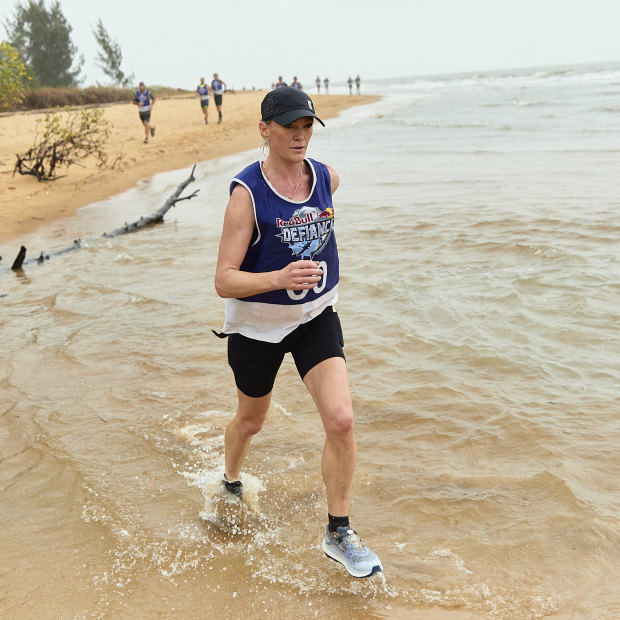
Writer Sarah Berry tackles the 150-kilometre Red Bull Defiance event in north Queensland. Ultramarathons like these have seen a 10-fold increase in participation rates over the past 20 years.
I’m some 20 kilometres into a 150-kilometre adventure race when I suspect I’m not going to make it. A gentle, steady stream of rain falls onto the red basalt track that is slowly twisting up to an elevation of 1050 metres through the dense rainforest of North Queensland’s Tully Gorge National Park. Steep sections of the rocky trail have dissolved into mud, and my feet, even in special trail shoes, are sliding on every step. Scrambling up slippery, lichen-covered boulders after wading through a creek crossing, I start to feel dizzy and a little nauseous.
I should have eaten more last night, I think. And: if this is how I feel now, I’m stuffed. Also: why on earth did I think I could do this thing?
This thing, as I come to call it, is the 150-kilometre Red Bull Defiance event, in which 71 teams of two aged between 19 and 59, about 70 per cent of whom are male, will white-water raft, kayak, trail run and mountain bike their way through stunning, demanding terrain to see if they can, as the marketing material challenges, defy the odds.
Six months earlier, while nursing a glass of pinot noir and eating from a bowl of ice-cream, I sat at my dining-room table and clicked “submit” on the application form. I wanted to do something to shake myself out of the sludgy routine I’d fallen into.
Returning to work after my second daughter was born turned out to be harder than I’d anticipated. Several years of sleep deprivation blurred all the edges of life into an endless expanse that was both comfortable and featureless. I coped with the monotony of work, parenting, cleaning and cooking with the same five-kilometre run three times a week, along with a steady diet of wine and chocolate.
These were my go-tos when I was delirious with exhaustion after another day of work on four hours’ sleep; when I felt lobotomised following three-hour bedtime battles. I wasn’t depressed, but I felt dulled and dull. So when my youngest was nearing two and was waking only twice a night instead of five or six times, I felt the fog lift enough to see I was wading through a slump of my own creation.
My own mum, through no fault of her own, had spent my childhood debilitated by depression. With two young daughters myself, I felt the need to prove something to them and to myself about what parents, what mothers, were capable of.
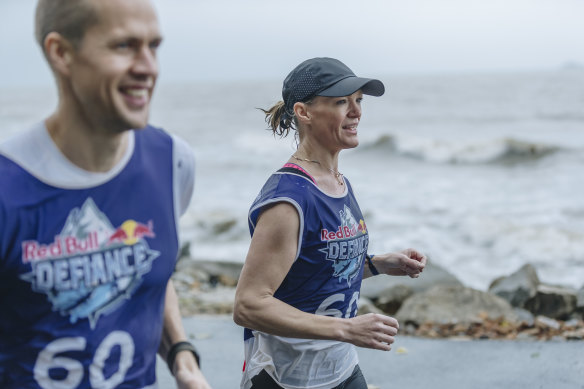
The author wanted to prove something to her daughters and to herself by running in the ultramarathon.
A 150-kilometre “adventure” race wasn’t what I had in mind. Having never run more than a half-marathon – 21.1 kilometres – it seemed impossible, but when a friend suggested it, I was surprised amidst the terror to feel a flicker of excitement.
The race would take place over two days around Mission Beach, two hours south of Cairns. Day one would start with a 10-kilometre white-water raft down the Tully River, through tumultuous grade four rapids. Next, we’d run 23 kilometres, winding up 1050 metres through thick tropical rainforest, before mountain biking for 53 kilometres, descending steeply and climbing up 1100 metres across river crossings and along old, unkempt fire trails. We’d have to keep watch for cassowaries, snakes and – possibly the most painful plant in Australia – the aptly named stinger tree.
Day two would commence with a 14-kilometre ocean kayak out to Dunk Island, an 11-kilometre run up the island’s Mount Kootaloo, a four-kilometre kayak back to the mainland, a 24-kilometre ride along the coconut palm-fringed Mission Beach, before finishing up with a 10-kilometre run through farmland and a coastal track looking out to the Great Barrier Reef.
My partner couldn’t understand why I’d want to put myself through something so punishing. “What is the point?” he asked.
When I mentioned the idea to family and friends, the general response was concern. I’d been a sprinter at school and always loved running, but my fitness had dropped off after the birth of my second child. I could count the number of times I’d been kayaking on three fingers, and my cycling experience was limited to a handful of spin classes.
My partner couldn’t understand why I’d want to put myself through something so punishing. “What is the point?” he asked, while reminding me of the high risk of injury. At dinner with girlfriends several weeks later, one joked that given the choice between a week in prison or doing something “horrible” like this, she would choose prison.
Not long ago, ultras were on the fringes of sport and sanity. Now, they’re brushing up against the mainstream. The past two decades have seen a tenfold increase in global participation rates in ultramarathons (races that last six hours or more), according to a study published in the journal Medicina earlier this year. This trend is being driven by women, whose participation rates have nearly doubled to 23 per cent in the past 15 years, and older people, with the average age of runners now between 40 and 50.
The pandemic brought a pause to ultramarathons, but they have picked up the pace – so to speak – once again. In October, Ultra-Trail Australia, the largest trail running event in Australia and the second-largest in the world (only behind France’s 171-kilometre Ultra-Trail du Mont-Blanc), organised a race in the Blue Mountains west of Sydney for distances up to 100 kilometres. More than 7000 runners lined up.
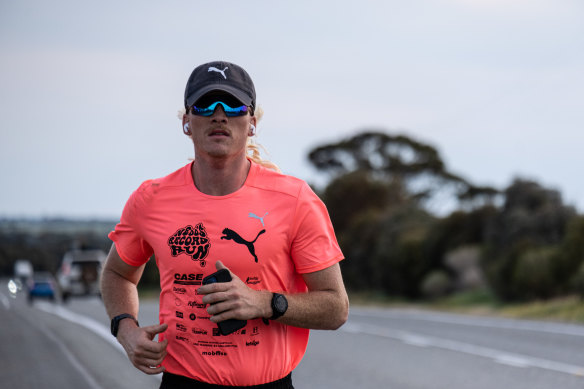
23-year-old Nedd Brockmann, who recently completed a run from Perth to Bondi in 47 days.Credit: Bradley Farley
Also in October, Nedd Brockmann, a tradie from the rural NSW town of Forbes, became an inspiration to many Australians when he finished a run from Perth to Bondi in 47 days. The 23-year-old, who said he only started running during the pandemic, battled runner’s knee, severely inflamed tendons and maggot-infested blisters. At a stop in South Australia’s Whyalla, a radiologist injected three cortisone shots into Brockmann’s tendon sheath to reduce pain and inflammation during the extremely arduous 3800 kilometres. He is no ordinary human.
So what are the risks to us mere mortals, who might be motivated by such a feat but who are not 23 and fit as a fiddle? The biggest danger, accounting for about half of deaths during ultras, is sudden cardiac arrest. “But it’s likely that most of these are due to unrecognised, existing conditions that may have an impact due to the stress,” says Tony Blazevich, a professor in biomechanics at Edith Cowan University in Perth.
It may also be due to a phenomenon called the exercise paradox, where we are more likely to have a cardiac event while exercising even though regular exercise ultimately reduces the overall risk, explains Andre LaGerche, head of clinical research at Melbourne’s Baker Heart and Diabetes Institute. “The highly trained heart is at increased risk of some heart arrhythmias such as atrial fibrillation, which is at least twice as common in endurance athletes.
“Heart rhythm problems can be life-threatening but the vast majority are a nuisance rather than a risk. Overall, the small excess of heart rhythm problems caused by exercise is vastly outweighed by the risks of not doing enough exercise.” Managing this risk involves increasing exercise in an incremental way, with progressive increases in duration and intensity, he adds.
Apart from the increased stress on the heart, the distance of ultra events puts extra strain on the body, particularly older bodies, heightening the risk of injury to the feet, calf muscles and Achilles tendons.
It can also lead to damage to the kidneys, especially when participants race over multiple days in hot conditions. Incidence of low blood sodium, or hyponatraemia, is higher in ultras because participants lose electrolytes through sweat and tend to ingest large volumes of fluid, which “waters down” sodium levels.
“This can cause cramping, nausea, intestinal discomfort, but also hallucinations, seizures and death,” Blazevich says. “Hyponatraemia, not dehydration, is the main cause of problems in ultras.”
Still, an increasing number of over-30s are choosing to put these concerns aside. Which doesn’t answer the question of why they commit to something so gruelling and taxing on the body.
It’s a cool Friday morning in August when I meet Jacqui Mooney in a cafe at the halfway point of the Bay Run, in Sydney’s inner-west. Mooney’s upbeat demeanour belies her grief. “I’m well,” smiles the 49-year-old, voice inflecting up, when I ask how she is coping.

Jacqui Mooney running the Bali ultramarathon in September in her late husband Jason’s place and with his best friend, David Jones.
Slender and make-up-free, Mooney is dressed in black activewear, her dark hair pulled back into a low ponytail. The only pops of colour are her acid-green running shoes, diamond studs and the flash of silver from her wedding ring. She sits back in a steel-framed chair, looking out to Iron Cove. This is Mooney’s “old stomping ground”, though she has been couch-surfing for months, waiting for renovations to be completed on the home she and husband Jason Cronshaw lived in – until he died, suddenly, in his sleep on April 15, aged 49. There was no obvious explanation as to why.
Mooney, a media consultant and former editor of Women’s Health magazine, had met Jason, or “Jase” as she calls him, as a 22-year-old at a backyard uni party on Sydney’s north shore. He asked her out that night and the couple remained together for 26 years.
Sipping a latte, she tells me she hated sport growing up, was not a runner and as an adult had wondered, “Who are these freakish people who go out running and say it’s fun? It’s the worst kind of torture.”
“You cannot think about the distance. That’s been a good analogy for my life right now. Don’t think too far ahead.”
Cronshaw was one of those freakish people who loved it so much, he eventually abandoned his corporate career to start ultra-event coaching and a running training group with his best friend, a lawyer and endurance runner. Before he died, Cronshaw was training for an 84-kilometre overnight run across Bali to raise money for the Bali Children Foundation, which aims to lift communities out of poverty. Mooney had planned to accompany him as support crew, as she often did at what she describes as her husband’s “crazy events”.
“I’d be waiting with the tub [of food, hydration and first aid] out in the bush,” she recalls. “I loved that. I loved being a part of that world, but I wasn’t on the athlete side.” Cronshaw’s enthusiasm for running slowly rubbed off on Mooney, who set a goal for herself for her 40th birthday: to be able to run a few kilometres, which she started by walking for one minute and jogging one minute and building to running twice a week.
Within 24 hours of her husband’s death, Mooney had decided to run the Bali ultramarathon in his place. The event, held in September, was “a way to honour Jase and prove to myself I could do hard things”. In the lead-up, she was running 90 kilometres a week. “You cannot think about the distance. That’s been a good analogy for my life right now. Don’t think too far ahead. It’s too overwhelming. Just one step at a time, and you will eventually get to the end.”
By immersing herself in the running community, Mooney was also able to draw comfort from a new “family” at a time when she had been all at sea with grief. “I don’t know where I’d be if I didn’t have this goal and this family who has supported me,” she says calmly.
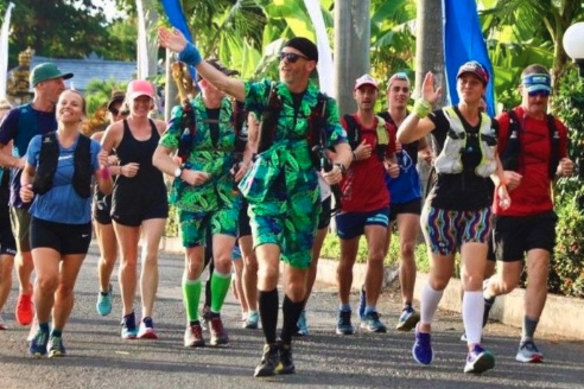
Jason running the Bali Ultramarathon in 2020. He had been training to run the event again when he died suddenly in April 2022.
Mooney’s close friend, experienced ultra-runner Samantha Gash, says that there is a “collegiate nature” in the ultra-endurance community, partly because the events were born more out of personal exploration and not professional sport. “Whether you are at the front of the line or the back of the line, you are sharing adversity, and it’s like you’re part of a club,” says the co-founder of Her Trails, which encourages female adventuring.
Also a mum to four-year-old Harry, Gash looks much younger than her 38 years, wears her hair in a girlish high ponytail and has a commanding presence despite her slight – just under five foot – stature. Like Mooney, she says she was “very uncoordinated” as a child and only started running in her late teens to manage her mental health while studying obsessively for her law degree.
Neither of her parents was a runner, but they lived near a lake in Bendigo, about 150 kilometres north-west of Melbourne, and suggested she get out there. “It would be dusk and there would be kangaroos going by, and I very quickly realised nature was my place, where I stopped fretting about what was to come and dwelling on what had passed,” Gash says. “For me, it’s never been about high performance. It stems back to, ‘This is the place I can just be.’ ”
In 2010, the then 26-year-old Gash became the first female and youngest ever person to complete Racing the Planet’s 4 Deserts Grand Slam event, which comprises four 250-kilometre ultramarathons through the Atacama, Gobi, Sahara, Antarctic deserts in one calendar year.
Recently in Nepal, Gash and another female explorer, Jess Ling, spent 50 days traversing 1600 kilometres across the Great Himalaya Trail, a trek that typically takes between 90 and 150 days to complete. They did it to raise money for World Vision Australia’s programs in rural Nepal, and Movember, which raises awareness about men’s health issues. Being away from her son for more than seven weeks was hard, she says, so she had to make it feel worthwhile. “There’s an element of guilt – a recognition of the burden you’re placing on your family to do something like this – then also a peace that it’s okay,” Gash reflects.
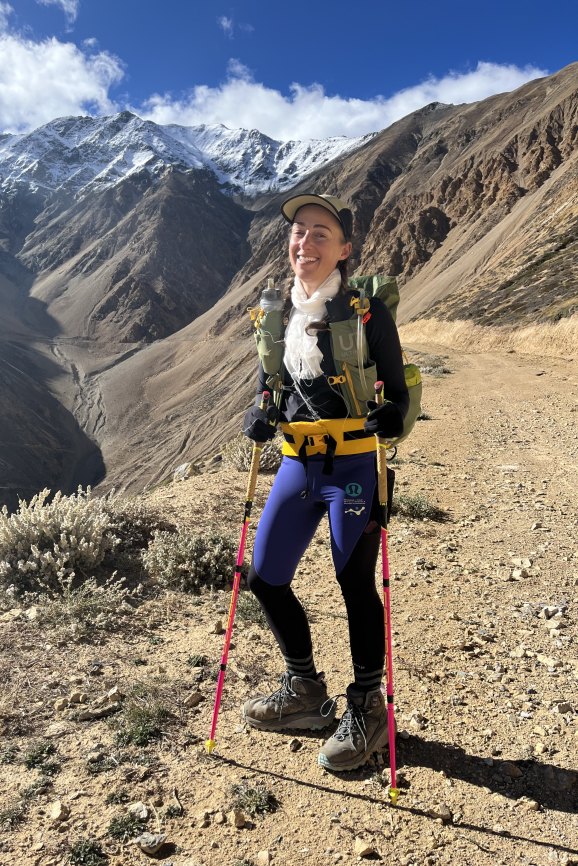
Endurance athlete Samantha Gash, who raised funds for charity by walking 1600 kilometres across Nepal in 50 days.
During Melbourne’s lockdown periods, Brock Bastian, a professor in psychology at the University of Melbourne, ran to shake off the edginess he felt. His older daughters scooted alongside him while he ran, pushing his two-year-old in the pram for 15 kilometres, after which he would collapse in a state of exhausted bliss. “You do literally change your mental state as a result of the exercise,” he says. “It’s very addictive in that sense and if you thrive on that intensity of feeling, that dopamine keeps you wanting more.”
In fact, Bastian notes, the enjoyment of exercise may well be maximised at the point of pain: “Often it’s about finding that line, just before it becomes unbearable, just before it becomes intolerable.”
“Often it’s about finding that line, just before it becomes unbearable, just before it becomes intolerable.”
As we push towards our edge, endorphin release may offset some of the pain. But Professor Bryce Vissel, director of the Centre for Neuroscience and Regenerative Medicine at Sydney’s St Vincent’s Hospital, says that, contrary to popular belief, endorphins do not create the exercise “high” that some people experience. Rather, researchers believe it comes from the cannabis-like substances humans naturally create, called endocannabinoids.
“Exercise boosts endocannabinoid release, especially levels of an endocannabinoid called anandamide, which is known to have positive effects on mood,” Vissel explains. “Higher-intensity exercise is far more likely to raise natural endocannabinoid levels.”
And when pleasure crosses the threshold into pain? Brock Bastion says it can provide a distraction. “The Latin word for pain is poena, which literally means punishment, so there’s this interesting overlap between pain and punishment,” he says. If you’re feeling bad about yourself or feeling bad in general, pushing your body hard physically and feeling pain resolves guilt,” he says.
Vigorous exercise also provides a kind of escape hatch in the brain. “When you’re running, you enter a different state of consciousness,” adds Bastion. “It’s very hard to worry about things in the same ruminative way you might normally. It doesn’t allow you to get stuck or bogged down in those thoughts.”
That exercise is beneficial for health is not exactly breaking news. It reduces the risk of chronic health conditions, including diabetes, heart disease, high blood pressure and cancer, and is linked to lower rates of dementia and depression. But more exercise does not always mean better outcomes.
“Ultramarathons definitely come with greater risk than half and full marathons,” cautions Professor Blazevich of Edith Cowan University, who points out that although we lose strength and speed with age, our bodies retain the ability to go at a slower pace for a long time. We also gain hybrid muscle fibres and resilience with age, which means older bodies respond well to endurance training.
Provided people do this and do not ignore pain in their bodies, Andre La Gerche says the downsides are few: “There are almost only upsides. The benefits of exercise at any level on cardiometabolic health and risk of heart disease are well established.”
Vissel adds that ultra endurance exercise, like moderate exercise, is also linked to better cognitive performance. “There are several other substances that are released from the brain and body during exercise, which promote ‘brain plasticity’, as well as improved metabolism and blood flow,” he says. “Brain plasticity is known to underpin learning and memory.”
Paige Hill, a senior psychologist at the Australian Institute of Sport and amateur half-marathon runner, says the mental component of ultras may explain the participation trend of older athletes. “It’s not just physical but all these other things, and some of that comes with age, ‘I’ve done all these other things that I wouldn’t have thought I could’ or ‘I’m regretful I haven’t done the things I wanted to, and now I really want to go out there and set goals and prove myself.’ ”
The difficulty of the activity can add a sense of meaning to the exercise, notes Bastian. “Sometimes pushing ourselves to our limits is about understanding what we are made of,” he says. “You can’t get the same feedback from taking an easy walk.”
Lachlan Spark is in a cafe in Queensland’s Innisfail drinking coffee out of a ceramic mug; something of a novelty at this point in his trip. He has just finished day 211 of 222 days of consecutive half-marathons from Hobart to Cairns, and when I wonder aloud about the links between self-punishment and ultras, he nods sagely.
He recalls a conversation with Mitch Wallis, the founder of the not-for-profit Heart On My Sleeve, which Spark chose to raise money for on his run, along with R U OK? Day. “We had a coffee and [Wallis] said, ‘You must have been through a lot in your life to want to put yourself through 222 half-marathons to even the ledger.’ ”
It struck a chord with the sun-bleached 43-year-old, who has a short, scruffy beard, intense blue eyes and an easy smile. “Two hundred and twenty-two half marathons is probably equivalent to 20 years of really struggling to find my place in the world,” says Spark, who describes his upbringing in Sydney’s north-west as dysfunctional. “So while a lot of people see this as a ridiculous, arbitrary, long, pointless exercise, for me there has been nothing but a point to it.”
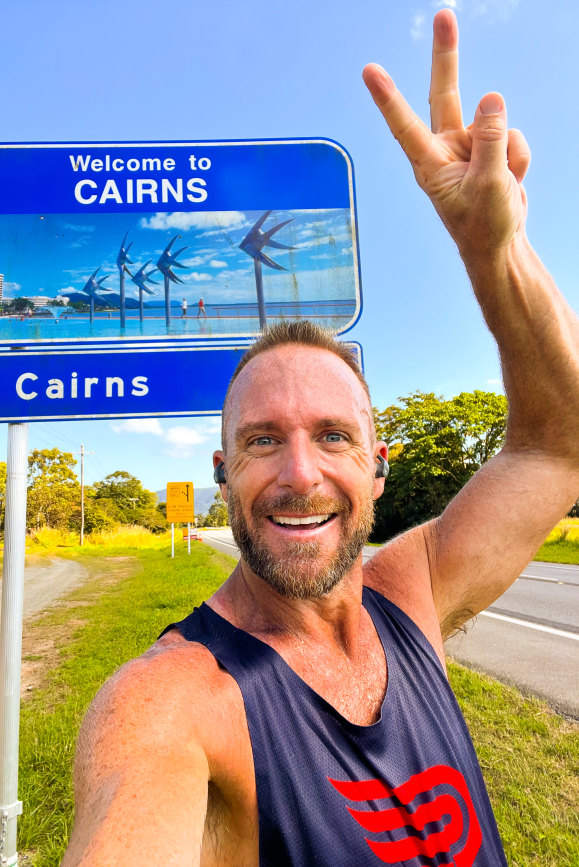
Lachlan Spark finally reaches Cairns after completing 222 days of consecutive half-marathons, beginning in Hobart.
Spark was living in Melbourne throughout his 30s working in a TV newsroom as a producer, in an unhappy marriage and struggling with his mental health when he first had the idea to run up Australia’s east coast. He can’t explain where it came from – he just wanted to do “something big” and thought it was a good opportunity for an adventure.
When his marriage eventually broke down, Spark moved to Sydney’s Bondi, started partying “pretty ferociously” and fell further out of shape, both physically and mentally – to the point where he was contemplating taking his own life. Through it all, the kernel of the idea sat in the back of his mind.
“It wasn’t about a physical need at all,” he says, looking into the distance out the window of the cafe. “I’d had a really acrimonious divorce, lost my friendships, business and house. It was about defining myself again after losing myself in that process. It was probably a redemption for me.”
On his first date with his new partner, Courtney, he told her about the run he dreamt of doing. “She said, ‘Cool, let’s do it,’ ” he recalls, smiling. And so began the long journey to the long adventure. By the time Spark got to his start line in Hobart on February 1, with Courtney by his side, he was so pumped for getting there and turning a “pie-in-the-sky idea into reality” that there was no risk he was going to stop.
And he has not stopped, despite enduring patella tendonitis on both sides, torn hip joints and stress fractures in his pelvis, not to mention losing all but one of his toenails. “It would be silly to suggest I wake up feeling great each day; I wake up and feel like I can barely get out of bed,” says Spark, who takes two paracetamols and two ibuprofens before each run.
“It would be silly to suggest I wake up feeling great each day; I wake up and feel like I can barely get out of bed.”
But it has been worth the pain on every level, he says. “That overriding anxiety that has been there my whole life until this point feels like it’s disappeared. I am calm for the first time in my life.”
Consistent exercise and not partying must help, but Spark attributes the feeling to the sense of purpose it has given him. “If I’d done this thing by myself without trying to raise any money for charity, it would be the most solitary and unfulfilling experience,” he says. “This has turned into something that’s about more than just me running up the coast.”
Along the way, strangers have stopped him to talk about their own experiences and struggles with mental health. Enabling those conversations and helping people feel safe to share their stories has created a further sense of purpose for Spark, who eventually finished his run on September 17 in Cairns. “I can do things that are good for me while also doing things for others,” he realised. “That’s the key takeaway. This is the only thing I’ve done that I’m really proud of.”
With Jason Cronshaw’s best friend running beside her, Jacqui Mooney completed the 84-kilometre Bali Hope Ultra on September 11. She’s not sure what’s next, but says she feels good. “I am stronger than I think, and I can survive this.”
For me, at the midway point of my own run, feeling dizzy and nauseous, I was not sure I was stronger than I thought. In the nights leading up to the event, I had wondered what would happen if I challenged my capabilities only to fall short; now I’d discovered I wasn’t, in fact, capable of very much.
In that space, in the silence, I was surprised to find that my internal voice, which was once critical and outright abusive, spoke up for me in support. It told me to keep going, “One step, one step, one step,” “Look around, be here” and “You can do this. You can do more than you think.” I felt space open up inside me that hadn’t existed before. I chewed on two salt tablets, drank some water and walked for a while alongside my teammate, a beacon of positivity and calm who, like a well-trained race horse, stayed by my side and never once made me feel bad for going slowly.
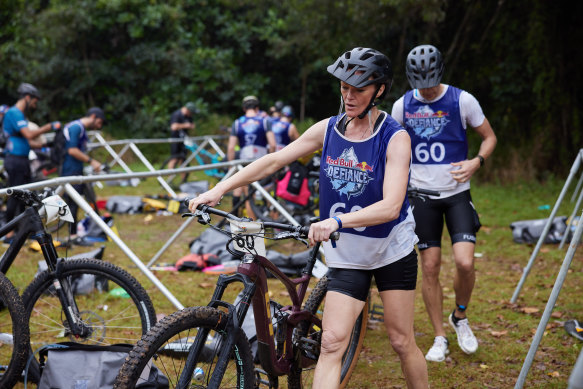
The author, who says she relied on her internal voice to get her through the event.
For a total of 16 hours and 43 minutes, we ploughed onwards. I made many rookie errors, like not taking enough hydration or nutrition with me; squirting energy gel into my eye; wondering why it was so hard to get water from the hydration vest I’d never worn only to realise the plastic seals were still on the mouthpiece.
Covered in mud, we pulled off leeches and wait-a-while vines that hooked onto us, and passed others, including a woman who had dislocated her shoulder after coming off her mountain bike, and people who had twisted ankles or were cramping up.
We were in deep discomfort, but I had caught the bug for this kind of adventure. The next day, as we were on the final mountain-bike leg, with only a few hours to go to the finish line and other cyclists whizzing past us, seemingly effortlessly, I caught myself thinking, “How are they going so fast? That’s impossible.”
And I reminded myself that only a few months earlier I had thought that making it this far, making it to the end, was impossible, too.
To read more from Good Weekend magazine, visit our page at The Sydney Morning Herald, The Age and Brisbane Times.